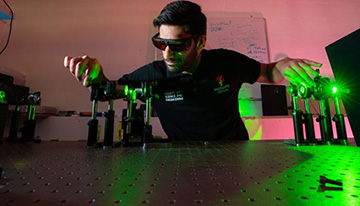
Seyed Abedi and other researchers at Macquarie University in Sydney have exploited stimulated Raman scattering in diamond to generate light pulses with randomly oriented polarizations. [Courtesy of the researchers]
The ability to generate truly random states of light’s polarization is essential to many implementations of quantum cryptography, but doing so currently relies on complex external equipment.
Now, however, a group of researchers in Australia has shown how the photons used to create secret cryptographic keys could have their polarizations randomly oriented at source by generating the photons in a piece of diamond. This demonstration, they argue, could potentially make cryptographic systems simpler and more secure (Opt. Express, doi: 10.1364/OE.410287).
Ensuring randomness
Classical processes such as coin tossing are not truly random since a precise knowledge of a system’s initial conditions could in principle allow its final state to be worked out ahead of time. That isn’t possible with quantum processes, however, since in this case the measurement of a system’s observable properties is inherently probabilistic.
Scientists have developed a number of quantum systems for generating random numbers, such as radioactive nuclei—with the delay between any one emitted particle and the next being impossible to predict deterministically. But exploiting such systems in quantum key distribution (QKD) means using them as external sources that impart randomization by modulating photon states.
The idea with the latest work is to do away with this modulation and ensure that the relevant photon property, in this case polarization, is in a random state to begin with.
Firing lasers at diamond
QKD involves the sender and receiver of a message creating a secret cryptographic key encoded in the quantum states of a string of photons. Many QKD protocols are based on the measurement of photons’ polarization, but rely on the receiver being able to choose at random which of two sets of polarizers they use to measure each photon. Otherwise, an eavesdropper could in principle work out the order of measurements in advance and then steal the key without altering its quantum state—so keeping their nefarious activity hidden.
Richard Mildren, Douglas Little and colleagues at Macquarie University in Sydney, Australia, have shown how to generate random polarizations directly by exploiting the phenomenon of stimulated Raman scattering. They fired intense 532-nm laser pulses at an 8-mm-long piece of diamond in an optical cavity, which set the material’s crystal lattice vibrating and generated photons at the slightly longer wavelength of 573 nm. Those photons stimulated the emission of yet further lower-frequency photons, the polarizations of which are described by a single coherent state.
The key to producing randomized polarization lies in diamond’s crystal structure, which consists of intersecting face-centered cubic lattices. By directing laser pulses along one specific crystal axis while fixing the pulses’ polarization along another, the lower-frequency photons’ axes of polarization naturally follow an isotropic distribution. That symmetry is then spontaneously broken by diamond’s quantum-mechanical zero-point motion—yielding Raman pulses with randomly oriented linear polarizations.
Beyond cryptography
The researchers recorded these polarizations by splitting each Raman pulse into two orthogonal components, delaying one of those components and then measuring their relative energies using standard, fast photodetectors. They found, as predicted, that the polarization orientations formed a smooth distribution between 0 and 90 degrees.
They also discovered that they could tune the degree of randomness by rotating the polarization of the incoming laser pulses away from diamond’s axis—showing that a rotation of just a few degrees transforms the smooth distribution into a pronounced peak at 45 degrees. They point out that the Raman pulses can be generated on-demand and at any wavelength compatible with the optical cavity, adding that pump lasers available today should allow key rates of several megabits per second—although in principle the new scheme could reach gigabits per second.
Little and colleagues say that their work isn’t over yet, however. Although they demonstrated that their measured polarizations were consistent with an “independent, identically distributed random output”—indicating that successive observations were not correlated with one another—they haven’t actually proved that this randomness has a quantum origin. To do that, they will have to establish nonclassical statistics by demonstrating a Bell inequality violation, with the immediate practical challenge, they say, being the generation of entangled states in diamond.
The researchers say that ultimately the system would need to be not only very fast but also miniaturized—probably chip based. What’s more, cautions Little, cryptography might not be the best-suited application. As he points out, QKD works at the level of single photons whereas their device pumps out classical pulses. Although the direct generation of random polarization might outweigh this disadvantage, he argues that the classical pulses may have other more natural uses. “[We] are hesitant to pigeonhole this laser as a QKD device,” he says.
